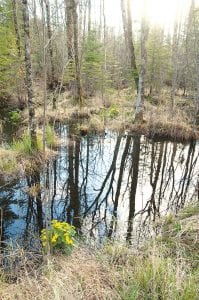Because most Minnesota lakes and rivers are surrounded by trees and shrubs, storms and winds often blow branches, limbs and trees into the water. Thiswoody material is important to lake and river ecosystems.
Beneath the water’s surface, fallen trees, limbs and branches are habitat for aquatic organisms at the base of the food chain. Valuable water insects such as mayflies graze on the algae that grow on decomposing wood. Invertebrates such as caddis flies build their pupal cases on branches and limbs. Dragonfly nymphs hunt for prey among the stems and branches. Invertebrates attract larger aquatic species, such as bluegills. Largemouth bass find food and shelter beneath fallen trees.
Above the water, a fallen tree is a great place for ducks and turtles to sun themselves. Muskrats use the tree as a feeding platform.
Predators such as mink and otter will hunt near fallen trees.
Kingfishers, ospreys, and songbirds perch in dead trees standing along the shoreline.
Many shoreland owners are choosing to keep woody materials on part of their shore and in shallow waters to provide cover and feeding areas for fish and wildlife. Unless the fallen tree is a hazard to navigation or swimming, consider leaving it in the water to improve fish and wildlife habitat, fishing, and wildlife watching.
To learn more, visit the Minnesota Department of Natural Resources Web site www.mndnr.gov.



Loading Comments